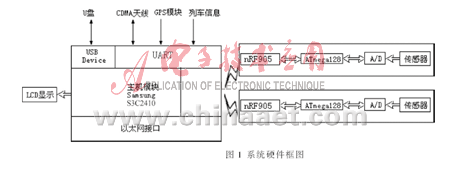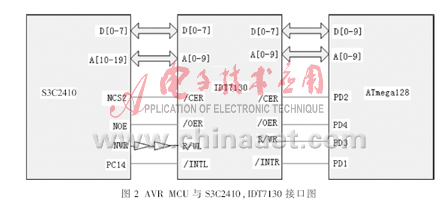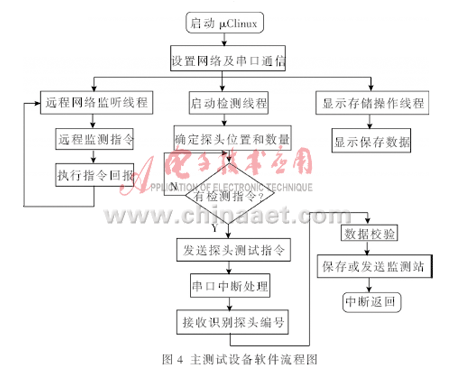Condition monitoring and fault diagnosis technology is the product of the development of modern industrial technology. It has developed to an advanced intelligent technology based on expert system, neural network and fuzzy analysis theory, based on network technology, and knowledge processing as the core. Linux and RFID have become hot spots of modern industrial technology. With the vigorous development of embedded technology, embedded systems have penetrated into national defense, network communications, and industrial control by virtue of their high cost performance, good stability, small size, and low power consumption. , Digital multimedia-related consumer fields. The hand-held intelligent fault diagnosis instrument for railways introduced in this article involves Linux, RFID, embedded data collection and wireless transmission functions and new technologies of embedded systems. This system is an embedded online monitoring and fault diagnosis instrument with knowledge processing as the core. It has the advantages of powerful function, easy to use, and easy to carry. The original data can be taken out through the USB interface for further post-processing. The system can also connect to the wireless network through the CDMA module, and send the processed data to the client in real time to achieve specific information query and alarm functions.
1 System composition and structureThis hand-held intelligent fault diagnosis instrument for railways is a set of intelligent instruments based on battery power supply. The test system is mainly composed of a test head, a main test equipment and a three-level test layer of a remote monitoring station. The front-end test head is mainly composed of AVR acquisition MCU, sensors and intelligent RF chips; the lower computer is a data acquisition system based on ATmega128 single-chip microcomputer, which is responsible for the acquisition of multi-channel on-site fast-changing and slow-changing signals, mainly completing task acquisition and receiving from the main acquisition equipment And execute the task scheduling of the master device. The main test equipment is mainly composed of ARM9 processor with embedded Linux operating system, intelligent RF chip, network and serial communication interface, storage device and display device. The main test equipment mainly completes the task distribution, data collection and analysis of each wireless collection point, and can simultaneously monitor and manage the sensor test heads within the range of several connected wireless networks, and can be transmitted to the remote monitoring station through the wireless data transmission module or through the Internet. And accept the task scheduling of the remote control station.
The remote monitoring station is mainly composed of a server, a monitoring database and peripheral equipment, which is divided into two parts: data acquisition (upper computer) and data processing (lower computer). It is responsible for real-time data processing, and it can also be downloaded to PC via USB port or Ethernet. On the above, carry out further in-depth fault trend analysis. The system reasonably decomposes the entire on-site monitoring task: the acquisition of analog signals, A/D conversion and simple data processing are implemented on the lower computer to control the hardware scale and power consumption of the system. The further processing of data, the components for real-time analysis on site, the reproduction of historical data and the simplified expert system are implemented on the upper computer. This article mainly introduces the research and design of wireless data transmission. The system framework is shown as in Fig. 1.

2.1 Smart nRF905 wireless transceiver chip
Increasing safe, reliable and stable wireless module functions is the technological trend of traditional PDA devices. The device uses Nordic's single-chip wireless transceiver chip nRF905. The chip works in the ISM frequency band of 433/869/915 MHz and consists of a fully integrated frequency modulator, a receiver with a demodulator, a power amplifier, a crystal oscillator and a regulator. , Can be easily programmed and configured through the SPI interface. The current consumption is very low, and you can easily enter the Powerdown mode to save power. nRF905 adopts VLSI ShockBurst technology, which enables nRF905 to provide high-speed data transmission and put the high-speed signal processing related to RF protocol inside the chip. In ShockBurst TX mode, nRF905 automatically generates the preamble and CRC check code, and the data is ready DR signal informs the master that its data transmission has been completed. The chip can be connected to the MCU of the test equipment ARM and AVR through a simple serial interface, which is easy to use.
2.2 ARM processor module
Build a portable embedded Linux ARM9 system. Embedded Linux is a widely used embedded operating system. The ARM processor module is jointly constructed by Flash, SDRAM and S3C2410. This system uses Samsung's K9F1208U0A to construct an 8-bit Flash memory system.
K9F1208U0A has a single-chip capacity of 64 MB: select two HY57V561620CTs with a single-chip capacity of 32 MB and a data width of 16 bits to construct a 32-bit SDRAM memory system in parallel. A total of 64 MB of SDRAM space can meet embedded operating systems and various complex algorithms Operating requirements. The ARM processor controls each module through the underlying drive control coprocessor to generate various control signals.
2.3 Sensor module
The sensor module can be selected according to the data collected. This system is developed on the basis of CAN bus wired data transmission. The CAN bus communication circuit is composed of microprocessor S3C2410, controller MCP2515, driver TJA1050, optocoupler 6N137 and power isolation module. CAN communication is mainly used in the harsh environment of locomotives Data collection. The wireless transmission function of the system is mainly used for the vibration measurement of the train locomotive body, and can also be used for the operation monitoring of the locomotive. Therefore, three acceleration measurement modules made of ADXL105 high-precision single-axis acceleration sensor chip are used. The measurement modules are respectively installed in the vertical and horizontal directions at the bottom of the car body to measure the acceleration of the car body in the X, Y, and Z directions. The measurement data is input to the precision amplifier in the form of differential signal, and then directly sent to the A/D module after comparison and amplification.
2.4 External communication module
The external communication module of the equipment is composed of 2 parts: 485 communication module and CDMA module. 485 communication interface adopts MAX1490 chip. This is a completely isolated 485 data interface chip, simplex working mode, the maximum transmission baud rate can reach 2.5 Mb/s. Its output pin is directly connected to the serial port 2 (UART2) of the ARM processor. The ARM processor reads the broadcast information of time and coordinates and other related data through the serial port 2. The serial port 0 (UART0) is connected to the AnyData DTGS800 CDMA module, and the monitoring data After preprocessing, it is sent to the ground server through the CDMA module.
2.5 System key hardware interface design
The main hardware interfaces of the system include the interface between AVR and nRF905, the interface between AVR and ARM9, and the peripheral interface of ARM9. This article mainly introduces the interface between AVR and nRF905 and ARM9. The AVR MCU sends and receives data through the nRF905 interface, and then writes the received data into the dual-port RAM and waits for the data to be read. In addition, the ARM9 writes the data to be sent into the dual-port RAM and sends an interrupt signal to the AVR MCU, and the AVR MCU then reads the dual-port RAM Read the data in the system and send it to the corresponding sampling sensor test head according to the instruction. However, due to the mismatch of the communication rate between ARM and AVR, the data exchange between the two CPUs is completed through a piece of dual-port RAM. Therefore, the asynchronous high-speed dual-port RAM IDT7130 is applied, which solves the bottleneck problem of asynchronous serial communication. The storage area of ​​dual-port RAM is divided into command area, status area, receiving data area, sending data area and interrupt area. Area. The subdivision of the receiving data area and the sending data area can be redistributed according to the actual needs of the number of serial ports and the length of the message. The handshake protocol between the master CPU and the slave CPU can be completed through the design of the command area and the status area. The main interface is shown in Figure 2.

3.1 Software system design
The system takes the main test equipment as the core, collects and collects the information collected by multiple test sensors, and collects and saves the test data, which can be transmitted to the monitoring center of the system in real time via the network for analysis and processing. The Linux kernel used in this design is based on ARM-Linux, and device drivers for OLED display modules and USB devices are written. The software design mainly includes the transplantation of ARM-Linux on the microprocessor S3C2410, related driver program design, system task-level design, etc. The development system uses a cross-compilation environment composed of a PC workstation and an embedded motherboard of the main test equipment. This system uses the Linux 2.6 kernel. The compilation of the kernel is carried out through the instructions of the Makefile. The modules of the kernel are organized by modifying the Makefile, and the modules are recorded. Interrelationships and dependencies, modify config, setup and other related configuration files to complete the kernel compilation, and generate zlmage, vmLinux, System.map, config and other files. The procedure of dual-port communication is shown in Figure 3.

3.2 Network communication program design
Embedded wireless local area network equipment can be used in occasions where the wired network cannot be extended or is difficult to install, and can be flexibly moved and temporarily used. In this system, the Socket communication method under Linux is mainly used, the TCP/IP network protocol stack is used, and the connection-oriented Stream socket is adopted.
During the operation of the main test equipment, it receives remote commands from the network. In order to facilitate remote measurement and control, each main test equipment is assigned a fixed IP address and port. The remote test station can perform selective inquiry measurement. A main test device uses socket() to establish a communication endpoint before the communication starts, and then uses the bind() function to bind an address to this endpoint, and then uses the listen() function to listen to whether there is a remote connection request, if If yes, use accept() to process, and perform measurement tasks or transmit measurement data according to instructions. As shown in Figure 4.

Although the two methods of on-site display and wireless transmission have provided a lot of data and information. But they are all restricted by region and space. Therefore, in order to meet the relatively harsh geographic environment and the collection requirements of mobile devices, the system can later add a wireless way of data transmission by adding GSM short messages. After years of development and improvement, the GSM network is now very mature, with fewer blind spots, stable signals, automatic roaming, and the communication distance is not affected by the surrounding environment.
The innovation of this paper lies in the development of a real-time detection system for locomotive status based on an embedded system, which realizes the collection of signals on the locomotive and the storage of signals, large-capacity data storage, stable and reliable CAN bus communication and remote wireless Communication, the various modules work in coordination under the dispatch of the Linux real-time operating system. The on-board display and voice alarm have good effects, and can remind the driver of the location of the fault and the method to solve the fault when the locomotive fails. The system has passed network communication test experiments under the embedded Linux environment, and proved to have better responsiveness and data throughput. The system design has certain application value and guiding significance in the field of non-contact measurement. It has been tested in locomotive testing. With multiple online debugging, the system works stably and reliably, and has a wide range of application prospects in the field of industrial control.
The utility model provides a disposable electronic cigarette, comprising: a hollow shell, the bottom of the shell is provided with a lower cover; the shell contains an atomizer, and the outer side of the atomizer is sheathed with a disposable cigarette A bomb, a microphone cover is arranged under the atomizer, a microphone is covered under the microphone cover, a battery is arranged on one side of the atomizer, and an upper cover is arranged on the top of the casing; The atomizer includes an atomizing corThe utility model provides a disposable electronic cigarette, comprising: a hollow shell, the bottom of the shell is provided with a lower cover; the shell contains an atomizer, and the outer side of the atomizer is sheathed with a disposable cigarette A bomb, a microphone cover is arranged under the atomizer, a microphone is covered under the microphone cover, a battery is arranged on one side of the atomizer, and an upper cover is arranged on the top of the casing; The atomizer includes an atomizing core, an oil-absorbing cotton sleeved on the outside of the atomizing core, and an atomizer outer tube sleeved on the outside of the oil-absorbing cotton. The disposable electronic cigarette provided by the utility model absorbs the smoke oil on the surface through the absorbing cotton, and then atomizes the smoke through the atomizing core, which greatly reduces the risk of oil leakage, at the same time, reduces the burning of cotton and ensures the smoking taste.e, an oil-absorbing cotton sleeved on the outside of the atomizing core, and an atomizer outer tube sleeved on the outside of the oil-absorbing cotton. The disposable electronic cigarette provided by the utility model absorbs the smoke oil on the surface through the absorbing cotton, and then atomizes the smoke through the atomizing core, which greatly reduces the risk of oil leakage, at the same time, reduces the burning of cotton and ensures the smoking taste.
disposable vape,vape pen,vape accessories,vape store,vape battery,e-cigarettes,Disposable Pod
Suizhou simi intelligent technology development co., LTD , https://www.msmvape.com